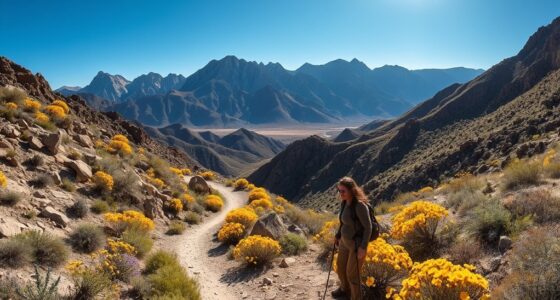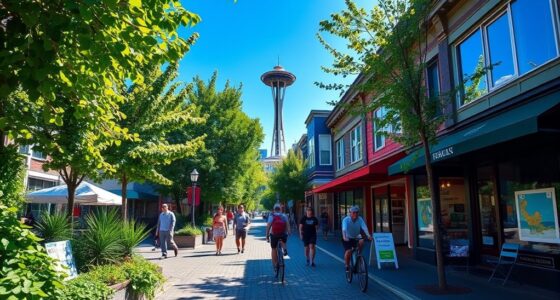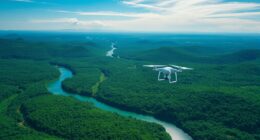Low-impact hiking in Yellowstone National Park lets you enjoy stunning scenery while safeguarding its unique ecosystems. By staying on designated trails, you minimize your impact on wildlife habitats and prevent erosion. Use lightweight gear and eco-friendly products to maintain the park’s pristine environment. Remember to observe wildlife responsibly by keeping your distance and using a zoom lens for photography. Discover how your actions can make a difference and ensure the park stays beautiful for future visitors.
Key Takeaways
- Stay on designated trails to protect Yellowstone’s ecosystems and prevent erosion while ensuring future access for visitors.
- Use camera zooms for wildlife photography to minimize disturbance and maintain a respectful distance from animals.
- Carry lightweight, eco-friendly gear to enhance your hiking experience and reduce your environmental footprint.
- Practice mindfulness by observing natural features, fostering a deeper connection with the landscape and promoting trail preservation.
- Follow Leave No Trace principles to keep the park clean and preserve its beauty for future generations.

When you explore Yellowstone National Park, embracing low-impact hiking not only enhances your experience but also helps preserve the stunning environment. As you set out on the trails, remember that every step you take can impact the natural landscape around you. By prioritizing low-impact practices, you’re not just being a responsible hiker; you’re also contributing to the long-term health of Yellowstone’s ecosystems.
One of the best ways to engage with the park’s breathtaking scenery is through wildlife photography. You’ll find that Yellowstone is home to an incredible array of wildlife, from bison and elk to the elusive wolf and majestic bald eagle. To capture these moments, you’ll want to tread lightly. Avoid straying off designated paths, as this can damage sensitive areas and disturb the animals. Staying on the trail is essential for trail preservation, ensuring that these pathways remain accessible for future visitors. The more you respect the trails, the better they’ll withstand the impacts of foot traffic.
Engage with Yellowstone’s stunning wildlife through mindful photography, respecting trails to preserve the park for future visitors.
As you hike, keep your eyes peeled for wildlife, but remember to maintain a safe distance. Use your camera’s zoom feature to capture stunning shots without intruding on their natural behaviors. This way, you can enjoy and document your encounters while minimizing your footprint on their habitat. It’s a win-win situation—beautiful photos for you and a safe environment for the animals.
Low-impact hiking also means being mindful of your gear. Opt for lightweight equipment and consider leaving unnecessary items behind. The less weight you carry, the less energy you’ll expend, allowing you to enjoy the journey and its beauty more fully. Additionally, using eco-friendly products—like biodegradable soap and reusable water bottles—will help keep Yellowstone pristine and clean. As you take part in outdoor activities, remember the importance of responsible hiking practices to ensure the preservation of natural habitats.
When you hike, take the time to appreciate the little things, like wildflowers and unique rock formations. By focusing on your surroundings instead of rushing to your destination, you’ll cultivate a deeper connection with nature. This mindfulness not only enriches your hiking experience but also reinforces the importance of preserving these trails for generations to come.
Ultimately, low-impact hiking in Yellowstone isn’t just about enjoying the scenery; it’s about being a steward of the land. Your actions today can shape the future of this remarkable park. So, pack your camera, lace up your boots, and embrace the beauty of Yellowstone while protecting it for all who come after you.
Frequently Asked Questions
What Should I Wear for Low-Impact Hiking in Yellowstone?
For low-impact hiking, you should wear appropriate footwear that offers good support and traction, like hiking boots or sturdy sneakers. Pair them with lightweight clothing that wicks moisture and breathes well, such as quick-dry shirts and breathable pants. Don’t forget to bring a hat and sunglasses for sun protection, and layers are essential in case the weather changes. Staying comfortable will make your hike much more enjoyable!
Are Pets Allowed on Hiking Trails in Yellowstone?
No, pets aren’t allowed on most hiking trails in Yellowstone due to the park’s pets policy. You’ll need to keep your furry friends in designated areas, like campgrounds and parking lots. If you do bring your pet, remember the leash requirements: they must be on a leash no longer than six feet at all times. For your pet’s safety and the park’s wildlife, it’s best to leave them at home when hiking.
What Are the Best Times of Year to Hike in Yellowstone?
The best times to hike in Yellowstone are late spring and early fall. During these seasons, you’ll enjoy milder temperatures and beautiful scenery. However, keep in mind that trail accessibility can vary; snow may linger into June, and some trails can close early in September. Always check the seasonal weather before your trip to make certain you’re prepared for changing conditions. Embrace the stunning views and wildlife during these ideal hiking months!
Can I Camp Anywhere While Hiking in Yellowstone?
You can’t just camp anywhere while hiking in Yellowstone; sticking to designated campsites is a must. Imagine the thrill of waking up to stunning views, but without following camping regulations, you might face hefty fines or damage delicate ecosystems. While it may seem restrictive, these rules help preserve the park’s natural beauty. So, plan ahead, choose a campsite, and enjoy the serenity that Yellowstone offers while respecting its environment.
How Do I Safely Encounter Wildlife While Hiking?
To safely encounter wildlife while hiking, keep a safe distance and never approach animals. Make noise to avoid surprising them, and stay alert for any signs of wildlife. Bear precautions are essential; carry bear spray, know how to use it, and store food properly. If you see a bear, remain calm, back away slowly, and never run. Respect their space, and always prioritize wildlife safety to ensure a safe and enjoyable experience.
Conclusion
When you embrace low-impact hiking in Yellowstone, you’re not just stepping onto trails; you’re walking on the very fabric of nature’s masterpiece. Every careful footfall helps preserve this breathtaking landscape for generations to come, making you a guardian of its wonders. So, lace up your boots and tread lightly, because your adventure can spark a ripple effect that echoes through time. Together, we can keep Yellowstone’s beauty as vibrant as a thousand sunsets.










